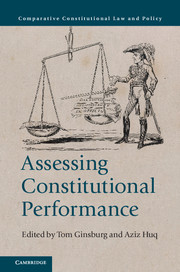Book contents
- Frontmatter
- Contents
- List of figures
- List of tables
- List of contributors
- Acknowledgments
- INTRODUCTION
- PART I DEFINING CONSTITUTIONAL PERFORMANCE
- 2 Hippocratic constitutional design
- 3 What is a good constitution? Assessing the constitutional proposal in the Icelandic experiment
- 4 When is a constitution doing well? The Alberdian test in the Americas
- 5 Parties and constitutional performance
- PART II MANAGING SPECIFIC CONSTITUTIONAL CHALLENGES
- PART III CASE STUDIES
- Index
5 - Parties and constitutional performance
from PART I - DEFINING CONSTITUTIONAL PERFORMANCE
Published online by Cambridge University Press: 05 August 2016
- Frontmatter
- Contents
- List of figures
- List of tables
- List of contributors
- Acknowledgments
- INTRODUCTION
- PART I DEFINING CONSTITUTIONAL PERFORMANCE
- 2 Hippocratic constitutional design
- 3 What is a good constitution? Assessing the constitutional proposal in the Icelandic experiment
- 4 When is a constitution doing well? The Alberdian test in the Americas
- 5 Parties and constitutional performance
- PART II MANAGING SPECIFIC CONSTITUTIONAL CHALLENGES
- PART III CASE STUDIES
- Index
Summary
An enterprise that seeks to compare the written provisions of all existing constitutions in terms of varying real-world outcomes is necessarily a highly complex one. Unfortunately there is yet a further complexity. The real workings of all constitutions depend in part not only on the institutional patterns they specifically provide but also on the nature of the party systems and the electoral arrangements of their polities, yet political parties and much of the electoral rules for most states are not provided for in their constitutions. Political regime A and political regime B might have identically worded constitutions but, nevertheless, vary greatly in their actual operations because of differing party systems and electoral rules. And, of course, party systems and electoral rules reciprocally influence one another. Each to some degree “causes” the other.
In the light of these considerations, I want to very tentatively and incompletely sketch how three general types of separation of power constitutions each may operate differently depending on which kinds of party systems and electoral rules are at play. Suppose one wished to compare parliamentary, presidential, and quasi- or semi-presidential constitutions to discover which type of constitution led to greater political stability, democracy, or other real-world outcome. Or suppose we pursued a narrower goal, say, asking in which of these constitutional types was judicial review more likely to succeed. Our findings might well be confounded if two parliamentary constitutional regimes operated in quite different ways because one enjoyed a two-party and the other a multi-party system. Showing the two together as if they were the same and then comparing them with presidential regimes to see which yielded more complete democracy or interest representation or whatever would yield very unsatisfactory results. You can compare apples to oranges if all the apples are pretty much the same as one another and all the oranges are about the same. You can't if some of the apples are very different from one another as are some of the oranges. If two-party presidential regimes actually are quite different from multi-party presidential regimes, it may not be easy to compare presidential constitutions with parliamentary constitutions that may themselves vary greatly in their actual operations because of differences in party systems.
- Type
- Chapter
- Information
- Assessing Constitutional Performance , pp. 134 - 142Publisher: Cambridge University PressPrint publication year: 2016
- 1
- Cited by



